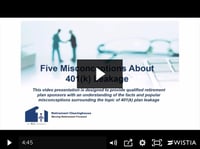 What is 401(k) leakage, and why should I care? This video presentation is designed to provide qualified retirement plan sponsors with an understanding of the facts and popular misconceptions surrounding the topic of 401(k) plan leakage.
What is 401(k) leakage, and why should I care? This video presentation is designed to provide qualified retirement plan sponsors with an understanding of the facts and popular misconceptions surrounding the topic of 401(k) plan leakage.
401(k) leakage is the premature distribution of retirement savings, prior to normal retirement age, and can deprive plan participants of a timely or comfortable retirement.
- The largest recordkeepers have produced studies that analyze leakage, and they all agree: it’s a big problem.
- The ERISA Advisory Council has taken up the issue of promoting lifetime plan participation, which – in large part – examines how to minimize this problem.
- High levels of cashouts adversely impact plan metrics, reduce average balances and increase recordkeeping fees.
However, there are plenty of misconceptions about 401(k) leakage. Let’s examine five of them.

Misconception #1: Loan defaults are the biggest type of leakage.
Not according to the GAO:
- Loan defaults represent only about 10.8% of cashout leakage.
- The largest single source of leakage are cashouts that occur post-job change, accounting for 88.5% of total leakage.
Misconception #2: Financial hardship is the single biggest cause of leakage.
Just over 1/3 of leakage is due to financial hardship:
- The GAO reports that in-service hardship withdrawals account for only 0.7% of leakage.
- Post-separation, 37% of cashouts are made for “emergency” purposes, where a participant has an urgent need for funds (Boston Research Technologies).
Thus, almost two-thirds of cashout leakage occurs for non-hardship reasons.
Misconception #3: Leakage is only a problem when participants change jobs.
It’s true - leakage IS a big problem when people change jobs.
However:
- Most leakage studies only look at distributions of participants who leave their jobs within any given calendar year.
- Leakage from “stranded” 401(k) accounts continues long after the employee leaves. This “slow leakage” can be significant, occurring steadily at annual rates of 6.5% to 12.3% for over 7 years following a job change.
Misconception #4: Cashout leakage by former employees doesn’t matter.
Many sponsors take the position that cashouts by separated participants doesn’t matter.
This is a short-sighted view:
- Participants are cashing out an employer’s matching contributions as well.
- In many industries (ex. – healthcare), employees periodically leave and return.
- Indifference towards the actions of separated participants is a position that’s inconsistent with fiduciary responsibility, not to mention corporate social responsibility.
Misconception #5: Small account leakage is not a big problem.
Even small-balance cashouts matter – particularly when they occur early in a career.
For example:
- When a 30-year old with a $1,679 balance cashes out, they’ll net $1,175 in cash, after taxes and penalties.
- That same participant who avoids cashing out and consolidates their balance into a new 401(k) could end up with $17,926 at retirement.
Where can I get additional information?
For more information, visit:
RCH1.com/auto-portability
